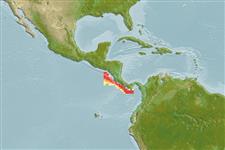Elasmobranchii (tubarões e raias) (sharks and rays) >
Squaliformes (Sleeper and dogfish sharks) >
Etmopteridae (Lantern sharks)
Etymology: Etmopterus: Greek, ethmos, -ou = sieve or ethmoides bone + Greek, pteron = wing, fin (Ref. 45335); benchleyi: Named for Peter Benchley, author of the movie Jaws and subsequently an avid shark conservationist..
Environment: milieu / climate zone / depth range / distribution range
Ecologia
marinhas; intervalo de profundidade 836 - 1443 m (Ref. 106129). Deep-water; 13°N - 6°N, 89°W - 80°W (Ref. 106129)
Eastern Pacific Ocean: from Nicaragua south to Panama.
Tamanho / Peso / Idade
Maturity: Lm ? range ? - ? cm
Max length : 32.5 cm TL macho/indeterminado; (Ref. 106129); 51.5 cm TL (female)
Descrição suscinta
Morfologia | Morfometria
This moderately large species is distinguished by the following set of characters: short snout with pre-narial length 2.9% TL (2.9-4.0%) and pre-oral length 7.8% TL (6.9-9.0%); broad mouth strongly arched, width 1.2 (1.0-1.5) times into pre-oral length; dentition show strong disjunct dignathic heterodonty with upper teeth comprised of single median cusp, flanked by 1-2 pairs of lateral cusplets, where lower teeth with low, distally-inclined cusps lacking serrations and a low posterior blade; dermal denticles are short, slender, with slightly hook-like conical crowns; denticles below second dorsal fin in irregular patch densities and align into rows along the ceratotrichia of the fins; denticles dense around the eyes and gill openings, sparse to bare on ventrum of snout tip and around mouth; first and dorsal fins similar in size; the second-dorsal-fin spine 1.7 (1.6-2.3) times longer than first-dorsal-fin spine; the second-dorsal-fin spine height greater than second-dorsal-fin apex; interdorsal-fin space is moderately long, 23.1% TL (19.2-21.4%); body color uniformly black, the anteroposteriorly oblong narrow pineal window apparent (Ref. 106129)
The larger individuals of this species were collected at greater depth than smaller specimens, suggesting a positive relationship between size and depth, as has been observed in E. princeps. The largest paratype (51.5 cm TL) contains five ova ranging from 25.6 to 34.2 mm, with no embryos apparent. The immature male paratype has claspers at the earliest stage of development, suggesting that maturity for males is attained at a greater size. Viviparous with litter sizes apparently consist of at least 5 pups with post-partum lengths less than 177 mm TL (Ref. 106129).
Ciclo de vida ou comportamento de acasalamento
Maturidade | Reprodução | Desova | Ovos | Fecundidade | Larvas
Vásquez, V.E., Ebert. D.A. and D.J. Long, 2015. Etmopterus benchleyi n. sp., a new lanternshark (Squaliformes: Etmopteridae) from the central eastern Pacific Ocean. J. Ocean Sci. Found. 17:43-55. (Ref. 106129)
Status na Lista Vermelha da UICN (Ref. 130435)
Ameaça para os humanos
Harmless
Uso pelos humanos
Mais informação
Nomes comunsSinônimosMetabolismoPredadoresEcotoxicologiaReproduçãoMaturidadeDesovaAgregação de desovaFecundidadeOvosDesenvolvimento dos ovos
Idade/TamanhoCrescimentoPeso-comprimentoComprimento-comprimentoFrequências de comprimentoMorfometriaMorfologiaLarvasDinâmica larvalRecrutamentoAbundânciaBRUVS
ReferênciasAquaculturaPerfil para aquaculturaEstirpesGenéticaElectrophoresesHereditariedadeDoençasProcessamentoNutrientsConversão de massa
ColaboradoresFotosStamps, Coins Misc.SonsCiguateraVelocidadeTipo de nataçãoÁrea branquialOtólitosCérebrosVisão
Ferramentas
Relatórios especiais
Baixar XML
Fontes da internet
Estimates based on models
Preferred temperature (Ref.
123201): 3.3 - 3.5, mean 3.4 °C (based on 6 cells).
Índice de diversidade filogenética (Ref.
82804): PD
50 = 0.5000 [Uniqueness, from 0.5 = low to 2.0 = high].
Bayesian length-weight: a=0.00380 (0.00191 - 0.00758), b=3.09 (2.92 - 3.26), in cm total length, based on LWR estimates for this Genus-body shape (Ref.
93245).
Nível Trófico (Ref.
69278): 4.2 ±0.6 se; based on size and trophs of closest relatives
Resiliência (Ref.
120179): Baixo, tempo mínimo de duplicação da população 4,5 - 14 anos (Preliminary K or Fecundity.).
Fishing Vulnerability (Ref.
59153): Moderate vulnerability (41 of 100).
